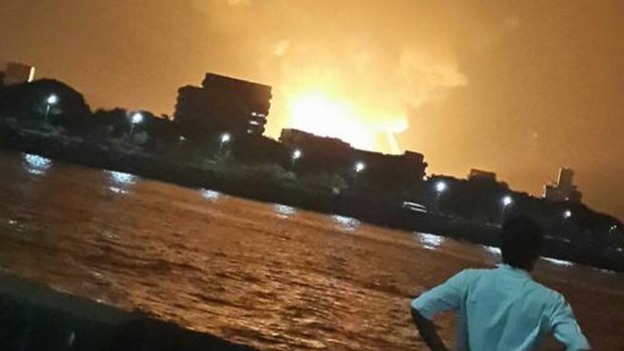
The Sinking of the INS Sindhurakshak Strains Russo-Indian Military-Technical Cooperation
Publication: Eurasia Daily Monitor Volume: 10 Issue: 152
By:

A series of explosions and a deadly fire ravaged the Kilo-type (project 877EKM or Varshavyanka) 3,000-ton submarine INS Sindhurakshak on August 14 as it was moored in Mumbai harbor and preparing to sail the next day, on August 15—India’s Independence Day. Eighteen sailors are feared to have perished in the disaster. The nose of the submarine was ripped open by an explosion: It sank but did not capsize, and its “sail” or fin is still rising above the water. A sister Kilo submarine, the INS Sindhuranta, moored alongside the INS Sindhurakshak, reportedly sustained some damage as a result of the massive explosion. The Sindhurakshak was built in St. Petersburg in the late 1990s. From 2010 to 2013, the Sindhurakshak was repaired and modernized in Russia in the Zvezdochka shipyard in Severodvinsk. The Sindhurakshak sailed from Severodvinsk last January and arrived in Mumbai last April, going more than ten nautical miles using its own diesel engines (Kommersant, August 15).
A team of Russian specialists from the Zvezdochka shipyard was in Mumbai to service the Sindhurakshak, but none were onboard when the vessel exploded and sank. Russia is ready to help the Indians investigate the cause of the catastrophe, but, reportedly, the Indians have refused to allow Russians specialists on the scene. The Sindhurakshak sank in relatively shallow waters and can be salvaged, though the severity of the sustained damage means it will most likely go to scrap anyway (Interfax, August 15).
In Severodvinsk, the Sindhurakshak was refitted with new batteries, new electronic communications equipment, sonar and, most importantly, Russian-made Klub-S (SS-N-27A) cruise missiles, giving the submarine important additional capabilities to strike enemy ships and land targets at ranges of up to 300 kilometers. The refitting of the Sindhurakshak cost India some $90 million (Kommersant, August 15). According to Indian sources, the price tag of the Sindhurakshak refitting was much higher—$156 million (https://timesofindia.indiatimes.com/india/At-156m-refit-expenses-on-INS-Sindhurakshak-exceeded-original-cost/articleshow_b2/21829702.cms?prtpage=1). Four other Indian-operated Kilo-class submarines have been refitted with Klub-S cruise missiles in Russia, including the INS Sindhuranta, which was reportedly somewhat damaged by the August 14 explosion. The loss of the Sindhurakshak is a severe blow to the Indian Navy. The Indians currently have 14 submarines, including a nuclear-powered K-152 Nerpa attack submarine (INS Chakra), leased from Russia. But apparently only half of those are ready for combat at any given time.
The Russian press and specialists are blaming the Indian sailors for “making grave mistakes,” which sank the Sindhurakshak, a diesel-electric submarine that uses either a snorkel to suck in air, or powerful batteries to propel it while underwater. During charging, the batteries emit hydrogen, which may ignite or explode. The INS Sindhurakshak had inbuilt safety precautions to control the hydrogen problem, but Russian experts and the press stress the Sindhurakshak’s Russian-made batteries were replaced in Severodvinsk during refitting with Indian-made Exide batteries. The makers of the Klub-S missiles—the Novator Design Bureau—told Kommersant their warheads “are absolutely safe and cannot detonate accidentally because of fire or anything.” The Zvezdochka shipyard told journalists the Sindhurakshak was in good order, the renovation was fine and the shipyard had done nothing possibly wrong that could have caused the disaster (Kommersant, August 15).
The blame shifting in the disaster between Moscow and New Delhi may seriously strain Russo-Indian military-technical cooperation, which has already been under pressure in recent years. During the Cold War, India was a staunch Soviet ally, while its archenemies Pakistan and China were allied to the United States. India received large amounts of Russian weapons, and the shipments continued after the Soviet collapse in 1991; the overall strategic balance in Asia slowly shifted, however, with Russia becoming increasingly close to China, while, in turn, the US became friendlier with India as its ties with Beijing and Islamabad withered. Since 1989, China is forbidden to import US or European Union military hardware. Whereas, India is free to buy from any Western source, including the US. The Russian share of India’s overall arms imports declined from 75 to 40–45 percent, but the volume of import of Russian arms has stayed constant. Indian military personnel often complain about outdated Russian equipment. “The Sindhurakshak disaster may cause some hostile articles in the Indian press, but they [the criticism in the media] are anyway bankrolled by the French,” says a leading Russian expert Sergei Lunev, “This wave will recede, and the Indians will continue to buy Russian since they are often themselves to blame for disasters with military hardware” (Nezavisimaya Gazeta, August 15).
In the past the delivery of Russian-made ships and submarines to the Indian navy was delayed because of technical mishaps. The former Russian carrier Admiral Gorshkov was initially planned to be delivered to India in 2008, but is still today in Severodvinsk. The price of the Gorshkov refurbishing has increased from the initial $1 billion contract signed in 2004 to $2.33 billion. Last year the Gorshkov’s main engine went bust during trials in the Barents Sea (see EDM, November 30, December 7, 2012), and today Russia is hoping to finally deliver it before the end of 2013 (Kommersant, August 15).
India is building French-designed Scorpene submarines, equipped with air-independent propulsion systems in Mumbai to eventually replace the diesel-electric Kilos. Russia has still not mastered the production of non-nuclear air-independent propulsion submarines or torpedoes, but the assembly of the Indian Scorpenes is years behind schedule. At present New Delhi is negotiating with Moscow the possible purchase (lease) of one more nuclear submarine to add to the Nerpa (RIA Novosti, August 15).
The most ambitious and costly Russo-Indian military project is to build a stealth fifth generation fighter aircraft or FGFA: only on R&D India must spend some $6 billion before 2020, with Russia adding another $6 billion. India plans to procure 144 FGFA jets, for an additional $15 billion or more (RIA Novosti, October 16, 2012). The Sukhoy Corporation boasts it already has four prototype T-50 FGFAs doing fly tests and that in 2016 the T-50 will go into serial production (Interfax, March 28). But Russia still does not have the new-generation jet engines, radars or weapons to fit the hull compartments of the T-50 (RIA Novosti, April 25). Acrimony over the Sindhurakshak disaster and other Indo-Russian military-technical mishaps may undermine the Indians’ will to spend billions on the unproven FGFA; and if this project stalls, relations could further sour.




